Masters of CG: Guillame Rocheron on designing Godzilla
How do you make a classic monster believable for a 21st century audience? MPC's VFX supervisor tells all.

Win a trip to Los Angeles!
This feature is brought to you in association with Masters of CG, a new competition that offers the chance to work with one of 2000AD's most iconic characters and win an all expenses paid trip to the SIGGRAPH conference. Find out more at the end of this article...
Creating a 21st century version of the classic movie monster Godzilla sounds like a dream job. But big creatures bring big problems.
Last week Kevin Sherwood told us of the issues posed by Smaug, the supersized dragon in the second Hobbit film. And it was a similar story for Guillame Rocheron, VFX supervisor for MPC, on Gareth Edward's 2014 Godzilla reboot.
MPC were responsible for designing all the creatures, and handled all the shots where Godzilla is fully visible. And they needed to seriously push the envelope to convince an audience weaned on shlocky monster flicks and wise to the 'look' of CG that this 350ft-high creature was the real deal.
Living and breathing
"Gareth wanted to keep everything designed in a way that could have been shot for real, so the effects would never feel fake - even though we were showing giant creatures stomping and fighting," Rocheron explains. "The main challenge was to make sure Godzilla was a believable living and breathing creature, both in his performance and in every single detail and deformation on his body."
That meant detailed research into real-life animal anatomy and movement: "We studied lizards, predators and bear fights to understand and come up with realistic animalistic behaviours," he says. "It was very important that Godzilla would come across as being a creation of nature."
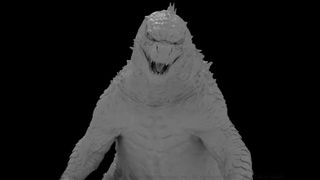
But that was only the half of it. "Because Godzilla is a character and not just an animal, we also had to introduce more humanized elements to his behaviour," he adds. "We had to find the right balance to make sure Godzilla was able to emote and have 'attitude' without falling into the realm of fantasy."
Get the Creative Bloq Newsletter
Daily design news, reviews, how-tos and more, as picked by the editors.
Bones and body language
Translating Godzilla from concept artwork to a photo-real living creature took his team of artists seven months, working up each part of his body, from the underlying bones, fat and muscle structure to the thickness and texture of his scales.
With the close-up nature of the camera work and the sheer scale of the monster, a tremendous amount of detail had to be painted and sculpted to ensure Godzilla came across in high-definition in a believable way.
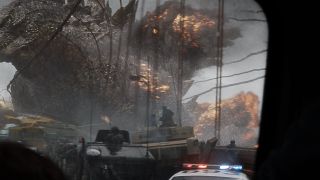
The artists also drew on a mixture of body language and carefully designed facial expressions to translate emotions and expressions on screen, without breaking the believability of the creature.
And to help convince the audience, what was going on around Godzilla needed to be equally convincing, Rocheron adds.
Battle of San Francisco
"The visual effects shots needed to be created realistically in terms of cameras to help the audience relate to the massive scale of the events," he says. "So for example, the third act battle in San Francisco is made up of shots from the the ground or rooftops - each providing a viewpoint at human scale.
"To re-enforce the sense of scale, we used interactive elements that conveyed a sense of gravity, he adds. "If you see a building collapse, swirling dust or dripping water moving really slowly against something, your brain immediately understand that you are watching something really big."
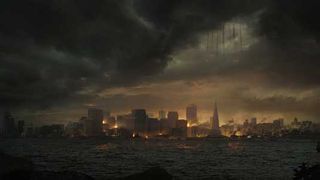
"Scale was our main focus," he emphasises, "so every shot contains an enormous amount of elements to help showcasing that scale. From the CG San Francisco, to the water, building and dust simulations, a large number of elements were required to create cohesive frames, offering Gareth control over virtual cinematography but at a very large scale."
Simulation software
To create the extremely high-resolution simulations of buildings collapsing and swirling interactive dust, MPC's in-house destruction simulation tool Kali was upgraded and given a number of significant incremental improvements to make photo-real destruction. The MPC software team added new tools to Kali for tetmesh creation and post-processing as well as giving it performance improvements, to allow faster simulation and rendering.
All in all, it was an epic challenge - but one aided by the fact that the director has a background in visual effects himself. "Gareth's understanding of visual effects allowed him to embrace the process and put all his focus on the creatures' performances and virtual cinematography," Rocheron enthuses.
And of course Rocheron could draw on his own vast experience, on movies including Harry Potter and the Half-Blood Prince, Man of Steel, The Secret Life of Walter Mitty and Life of Pi, for which MPC won an Academy Award.
A life in movies
An industry veteran, Rocheron's career began by making when he was in high school and he started experimenting with computer graphics and making his own short films. "This is how I got my first job, at BUF Companie in Paris," he explains.
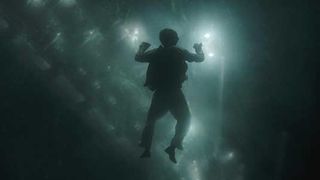
"At that time, each artist was responsible for his own shot from start to finish. Because you had to do everything, this taught me how to think first about shot design and best technical approaches." It's a grounding that's served him well. Now in his ninth year at MPC, he's currently working on Batman v Superman, and enjoying his job more and more with every film.
"Visual effects are getting more and more versatile, allowing filmmakers to use them in new and creative ways," he explains. "Being able to offer directors better ways to achieve their vision is making my job increasingly interesting.
"Godzilla was a great experience in that regard, because we could focus along with the filmmakers on the creatures' personality and performances as well as the shot design and virtual cinematography, allowing Gareth to achieve the iconic and singular visual style he was after."
Win a trip to Los Angeles!
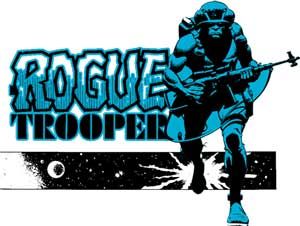
Masters of CG is a competition for EU residents that offers the one-in-a-lifetime chance to work with one of 2000AD's most iconic characters: Rogue Trooper.
We invite you to form a team (of up to four participants) and tackle as many of our four categories as you wish - Title Sequence, Main Shots, Film Poster or Idents. For full details of how to enter and to get your Competition Information Pack, head to the Masters of CG website now.
Enter the competition today!

Thank you for reading 5 articles this month* Join now for unlimited access
Enjoy your first month for just £1 / $1 / €1
*Read 5 free articles per month without a subscription

Join now for unlimited access
Try first month for just £1 / $1 / €1
The Creative Bloq team is made up of a group of design fans, and has changed and evolved since Creative Bloq began back in 2012. The current website team consists of eight full-time members of staff: Editor Georgia Coggan, Deputy Editor Rosie Hilder, Ecommerce Editor Beren Neale, Senior News Editor Daniel Piper, Editor, Digital Art and 3D Ian Dean, Tech Reviews Editor Erlingur Einarsson, Ecommerce Writer Beth Nicholls and Staff Writer Natalie Fear, as well as a roster of freelancers from around the world. The ImagineFX magazine team also pitch in, ensuring that content from leading digital art publication ImagineFX is represented on Creative Bloq.
